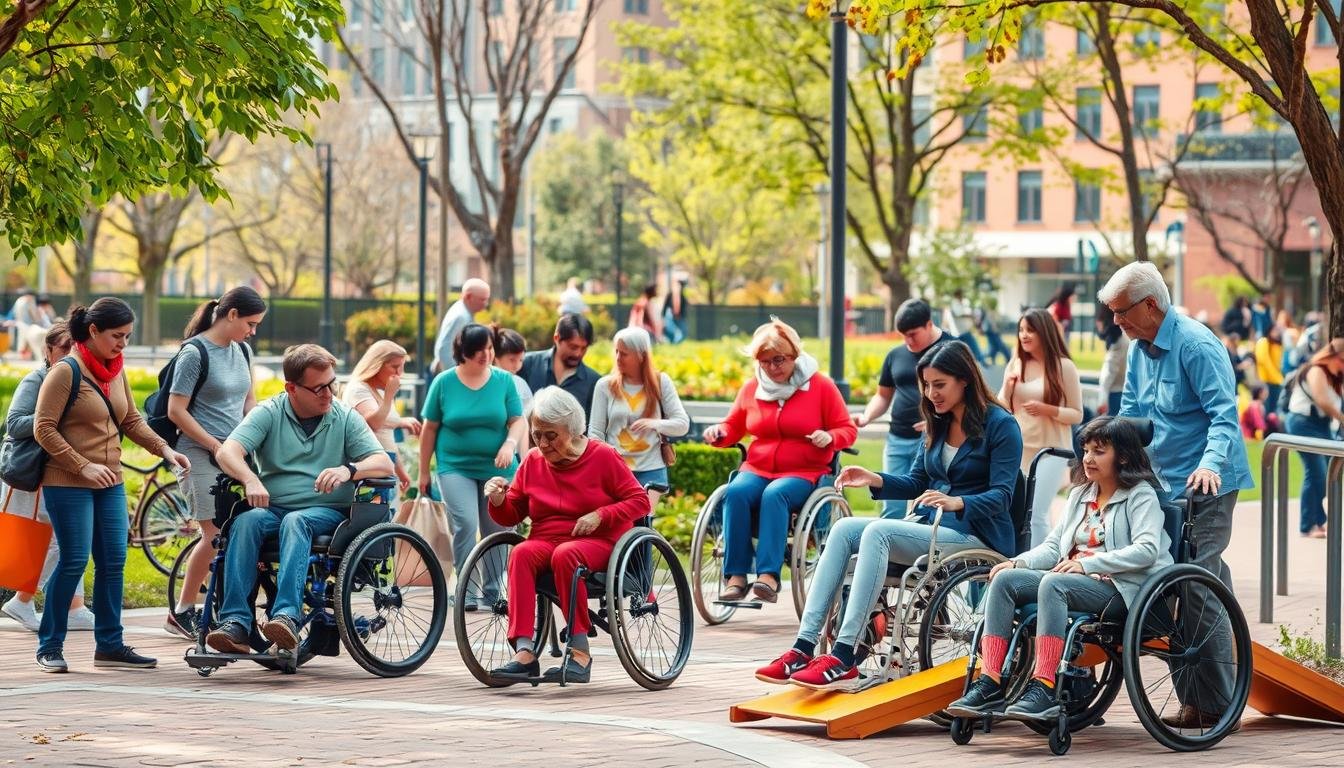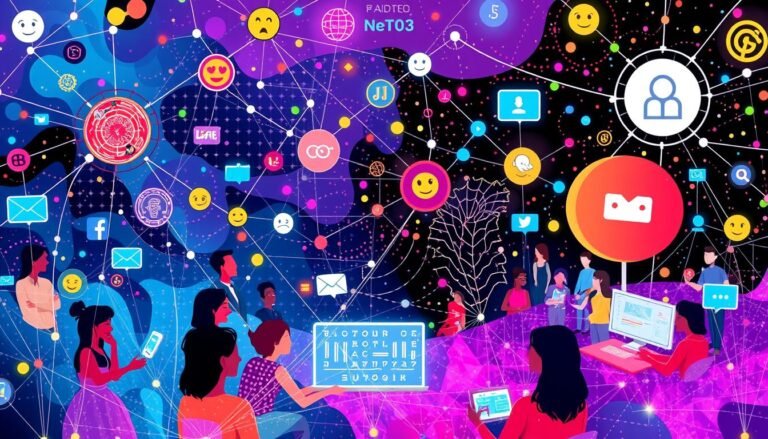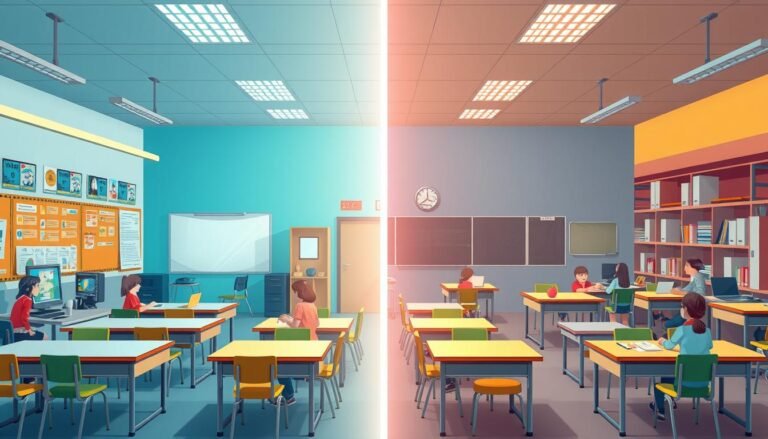Understanding the Sociology of Disability
Have you ever thought about how society affects disabled people? This is what the sociology of disability is all about. It looks at how society and disability are connected in complex ways.
The sociology of disability started in the 1980s. It came as a reaction to the old medical model that only looked at individual problems. Now, it focuses on the barriers that disabled people face every day. It shows how social rules, policies, and places affect their lives.
Important thinkers like Mike Oliver and Colin Barnes have greatly helped disability studies. They’ve created theories that talk about disability rights and the social model of disability. This idea says society disables people, not their conditions.
As we dive deeper, we’ll see how disability affects different people in different ways. We’ll look at how disability rights movements have changed things. We’ll also see the fight for schools and jobs that include everyone.
Key Takeaways
- Sociology of disability challenges traditional medical views
- It focuses on societal barriers rather than individual impairments
- The social model of disability is a key concept in the field
- Disability studies intersect with other social identities
- Inclusive education and employment are ongoing challenges
Introduction to the Sociology of Disability
The sociology of disability looks at how society affects disabled people’s lives. It moves past the idea that disability is just about individual problems. It shows how disability identity, culture, and society work together.
Defining the Field of Study
This field studies how society’s norms, policies, and views change disabled people’s lives. It looks at how disability is made by society and its effects on people.
Historical Development of Disability Studies
Disability studies started in the late 20th century, reacting against the old medical view of disability. Scholars moved from focusing on personal issues to seeing the social barriers that cause disability. This shift led to the social model of disability, which has helped disability rights movements.
Key Scholars and Their Contributions
Many scholars have greatly helped disability studies. Their work has shaped our view of disability identity and culture. Here are some important figures:
| Scholar | Contribution |
|---|---|
| Len Barton | Challenged special education paradigms |
| Sally Tomlinson | Examined societal structures in education |
| Mike Oliver | Developed social model of disability |
These scholars have greatly helped us understand disability as a social issue. They mix academic depth with a drive for change. Their work still shapes disability studies and activism around the world.
Theoretical Frameworks in Disability Studies
Disability studies have changed a lot in the last 20 years. The social model of disability is a key change. It moves focus from what’s wrong with people to how society makes them disabled.
The medical model used to be the main way to look at disability. It focused on finding cures and treatments. But the social model says disability comes from how society is set up, not from the person.
The affirmation model is another big idea. It says disabled people are not tragic figures. Instead, it celebrates their lives and experiences. This has helped create a sense of pride among disabled people.
“Disabled people are starting to have an impact on scientific research, which brings challenges to positivist research and the notion of objectivity.”
Critical Disability Theory (CDT) looks at disability as something made by society. It points out that being disabled doesn’t mean you’re less equal. CDT says we need to listen to disabled people to change how society sees them.
| Framework | Focus | Impact |
|---|---|---|
| Social Model | Societal barriers | Policy changes |
| Medical Model | Individual impairments | Clinical interventions |
| Affirmation Model | Positive experiences | Disability pride |
| Critical Disability Theory | Social construct | Rights advocacy |
These ideas help us understand disability better. They affect research, policies, and how people see disabled individuals. They guide us in fighting for disabled rights and making society more welcoming.
The Social Model of Disability
The social model of disability changed how we see disability rights. It moved focus from personal issues to the social barriers that stop people from joining in. This is different from the medical model, which sees disability as a problem to be fixed.
Contrasting with the Medical Model
The social model puts the blame on society, not the individual. It says that if places were easy to get around, people with disabilities wouldn’t be held back. This idea greatly affects how policies and actions are made.
| Medical Model | Social Model |
|---|---|
| Focuses on individual impairment | Focuses on societal barriers |
| Aims to “fix” the person | Aims to change society |
| Views disability as a problem | Views disability as a difference |
Strengths and Criticisms
The social model is empowering. It says society must remove barriers. But, some say it ignores how impairments affect people’s lives. Finding a balance in disability studies is hard.
Impact on Disability Rights Movements
The social model has greatly influenced disability rights efforts around the world. It helped create the Americans with Disabilities Act, which stops discrimination. This model keeps pushing for changes, making society more inclusive and accessible.
“Disability is something imposed on top of our impairments by the way we are unnecessarily isolated and excluded from full participation in society.” – Union of the Physically Impaired Against Segregation (UPIAS)
Intersectionality and Disability
Intersectional analysis shows how disability and other social identities work together. It highlights the special challenges faced by people in more than one minority group. For example, the mix of disability and gender makes their experiences unique and requires a deeper understanding.
Research finds that disabled women are at a higher risk of facing discrimination and violence. A shocking 85% of disabled people have experienced gender-based violence. This shows we need strong support systems for disabled women.
But the effects of these inequalities go beyond just safety. In schools, 60% of disabled girls are missing out on inclusive education. This shows we must have special plans that think about both disability and gender in education.
| Intersectional Factor | Percentage Affected |
|---|---|
| Disabled women experiencing intersecting inequalities | 75% |
| Disabled individuals experiencing stigma across conditions | 70% |
| Disabled women feeling excluded from development research | 60% |
The table shows how intersectionality deeply affects disabled people. We see that fighting for disability rights means looking at the complex nature of identity and experience.
As we learn more about intersectionality in disability studies, we get important insights. These insights help us make policies and practices that include everyone. This is key to building a society that values and supports everyone, no matter their identities.
Understanding the Sociology of Disability
The sociology of disability looks at how society affects disabled people. It studies important ideas that shape their identity and the barriers they face.
Key Concepts and Principles
The social model of disability is key. It’s different from the medical model, which aims to cure impairments. The social model says we need to get rid of barriers in society. It believes disability comes from how society is set up, not just from individual differences.
Societal Attitudes and Stigma
Stigma greatly affects how society sees disability. This can lead to discrimination, making people with disabilities less likely to use their skills. To fight stigma, we need to spread awareness, teach inclusively, and make laws against discrimination.
Social Structures Shaping Disability Experiences
Disabled people face big challenges because of society’s setup. But, we can make things better. For example, ramps, support for living on your own, and audio books for the visually impaired help a lot. These changes help people be more independent and equal.
| Model | Focus | Outcome |
|---|---|---|
| Medical Model | Fixing impairments | Reduced independence |
| Social Model | Removing barriers | Increased inclusivity |
By changing how society sees and supports disabled people, we can make a place that values everyone’s identity. This way, we can reduce the barriers they face.
Disability Identity and Culture
Disability culture is a big part of many lives, giving people a sense of who they are and where they fit in. It’s all about celebrating differences, breaking down stereotypes, and pushing for everyone to be included. Let’s dive into how disability identity comes to be and its place in our world.
Formation of Disability Identity
Disability identity comes from how we see ourselves and how others see us. It’s shaped by many things, like:
- Our health conditions
- How others treat us
- Our support networks
- Our background
The social model of disability says that society’s choices affect our lives a lot. Things like the design of places, the tech we use, and laws can lead to unfair treatment.
Disability Pride and Community
Feeling proud of being disabled helps build strong communities. It helps people see themselves in a good light and fight against bad stereotypes. Disability culture boosts this pride with:
- Special slogans and items
- Cultural spots
- Events for the community
- Groups for support
These things make people feel they belong and give them the courage to be proud of who they are.
Representation in Media and Arts
How we see disability in the media shapes our views on it. Disability culture is now showing up in many art forms:
- Films and TV shows
- Literature
- Theatre and dance
- Visual arts
These art forms challenge wrong ideas, teach us, and celebrate the unique lives of disabled people. By showing real stories, media can help fight stigma and make understanding grow.
“Disability is not a brave struggle or courage in the face of adversity. Disability is an art. It’s an ingenious way to live.” – Neil Marcus
Policy, Advocacy, and Disability Rights
The disability rights movement has changed policies and laws for people with disabilities. Elizabeth Pendo, a Senior Associate Dean at the School of Law, and Katie Warden, Director of the Northwest ADA Center, have greatly helped in this effort.
Laws like the Americans with Disabilities Act (ADA) and special education laws are key to the Disability Rights Movement. They fight against disability discrimination and push for equal chances. The Disability Justice Movement looks at bigger issues and how they affect different groups.
David Pettinicchio’s book “Politics of Empowerment” talks about how federal policy affects disability rights. It shows how there’s a mix of progress and setbacks in American disability policy. It talks about what’s been done well and what still needs work.
- The U.S. is both a leader and a follower in disability rights
- Government leaders helped start disability rights in the 1970s
- Federal policies have helped disabled people become more active citizens
The Internet has changed how people advocate for disability rights. Now, people can use social media and the web to share their stories and explain policy changes. This has brought a new group of young, tech-savvy disabled advocates, especially in Britain.
Even with progress, there are still big challenges. Many disabled people can’t easily get online, and the fight for full civil rights is far from over. The disability rights movement keeps growing, using new tech and tackling tough social issues.
Challenges and Future Directions in Disability Studies
The field of disability studies is facing exciting challenges as it moves forward. With 26% of U.S. adults living with at least one disability, its impact is huge. People with disabilities are changing how we think about diversity and inclusion.
Emerging Technologies and Bioethical Debates
New technologies are changing the game for disabled individuals. These advancements offer hope but also raise tough ethical questions. The disability community is leading discussions on genetic editing, assistive tech, and AI.
These talks will influence how society sees disability in the future.
Inclusive Education and Employment
Improving inclusive education and disability employment is key. Schools and workplaces are changing to meet diverse needs. This change shows a growing view that disability is a social issue, not just a medical one.
The aim is to make spaces where everyone can succeed, no matter their ability.
Global Perspectives on Disability
Global disability studies are broadening our view of disability worldwide. This wider perspective shows how culture, economics, and politics affect disability rights globally. As the field grows, it’s linking with feminism, bioethics, and Queer Studies.
These connections are building a deeper, more detailed understanding of disability in our global society.
Source Links
- Sociology of Disability
- The Sociology of Disability and the Struggle for Inclusion
- Understanding Disability: A Sociological Perspective
- The Sociology of Disability (Chapter 27) – The Cambridge Handbook of Sociology
- Microsoft Word – disbody.doc
- Theories in health care and research: Theories of disability in health practice and research
- Hosking – Abstracts – 4th Biennial Disability Studies Conference, Lancaster University, UK 2nd
- Scoping models and theories of disability – Implications for public health research of models and theories of disability: a scoping study and evidence synthesis
- The Social Model of Disability Explained — Social Creatures
- The social model of disability – Sense
- Social model of disability – People with Disability Australia
- Disability and other identities?—how do they intersect?
- Disability at the Intersections
- Understanding Disability Discrimination in Sociology
- Social Model vs Medical Model of disability – disabilitynottinghamshire.org.uk
- Understanding Disability Identity, Community, and Culture | UMass Office of the President
- Disability culture | Inclusion, Advocacy & Identity
- Legal Understandings of Disability Rights vs. Disability Justice | UW School of Law
- Politics of Empowerment: Disability Rights and the Cycle of American Policy Reform – David Pettinicchio
- Disability Rights Advocacy Online: Voice, Empowerment and Global Connectivity
- Shifting the Discourse on Disability: Moving to an Inclusive, Intersectional Focus
- Disability Studies: What it is and what difference does it make?







